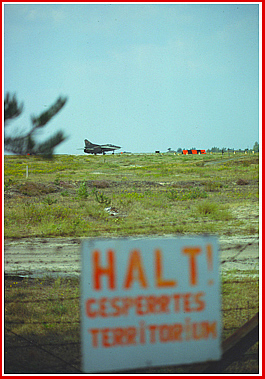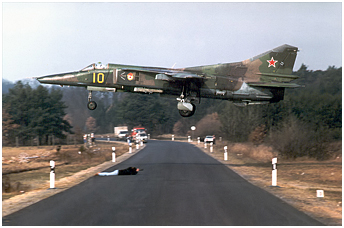 Premier contact! Un MiG-23UB monte sur la piste de Finsterwalde.
A l'avant-plan, attaché à la clôture, un avertissement qui ne demande aucune traduction. © E. Bannwarth.
Premier contact! Un MiG-23UB monte sur la piste de Finsterwalde.
A l'avant-plan, attaché à la clôture, un avertissement qui ne demande aucune traduction. © E. Bannwarth.
First contact! A MiG-23UB is aligning on Finsterwalde runway. In the foreground, attached to the fence, a warning sign
which is unnecessary to translate. © E. Bannwarth
The last decade of last century will probably be reminded by History as the period when
the bipolar international order issued from the Second World
War has been swept without open warfare. Begun after the invasion of Afghanistan by a sudden worsening of the Cold War, the
eighties were marked, from 1985-1986, by a sudden and significant improvement of relations between the two political blocks
directing the world affairs.
Although certainly influenced by the Soviet policies of perestroïka (reconstruction) and glasnost (openness),
this new détente was mainly the result of a change in the global balance of powers, generated by the most fabulous arms races
the world had ever known. A race finally abandoned and then lost - for want of adequate financial reserves - by the Soviet Union,
which signified the end of the geopolitical confrontation between East and West, drawing the multipolar world as we know it
today, dominated by the only power still having the technology, economic and military resources sufficient to impose its views
to other nations on the planet: the United States of America. Defeated, U.S.S.R. had no choice but to bow and accept, after the sudden
collapse of the Iron Curtain and the disappearance in 1991 of the Warsaw Pact, its own implosion and the widespread withdrawal
of its forces from the countries of Central Europe and, thereby, the definitive end of the hegemony exercised by Moscow over this
part of the world - and many others - since the end of the Second World War.
 It is in the psychologically difficult context of a defeat without combat that the Russian army evacuated between March 1991
and September 1994, all its forces settled in Germany, allowing for a brief period of four years to
West European aircraft enthusiasts the discovery, a few hundred miles from home, of aircraft and helicopter
hitherto mostly fantasized:
the fighters MiG, Sukhoi and other Mil helicopters decorated with the red star of Soviet Military Air Forces (VVS).
It is in the psychologically difficult context of a defeat without combat that the Russian army evacuated between March 1991
and September 1994, all its forces settled in Germany, allowing for a brief period of four years to
West European aircraft enthusiasts the discovery, a few hundred miles from home, of aircraft and helicopter
hitherto mostly fantasized:
the fighters MiG, Sukhoi and other Mil helicopters decorated with the red star of Soviet Military Air Forces (VVS).
 "After having contemplated silhouettes and blurred images gleaned here and there for such a long time, to actually see MiG or
Sukhoi on a runway, to see the mechanics at the last chance point before the last flight from Germany, to mingle with
families before they return to the Motherland, was really worthwhile. I doubt that it will ever be possible, even for the youngest
of us, to attend a departure after a second Great Patriotic War and a new occupation! History
never plays twice the same play ..." (1).
On September 30, 1994 the last Russian soldier left the territory of reunified Germany.
"After having contemplated silhouettes and blurred images gleaned here and there for such a long time, to actually see MiG or
Sukhoi on a runway, to see the mechanics at the last chance point before the last flight from Germany, to mingle with
families before they return to the Motherland, was really worthwhile. I doubt that it will ever be possible, even for the youngest
of us, to attend a departure after a second Great Patriotic War and a new occupation! History
never plays twice the same play ..." (1).
On September 30, 1994 the last Russian soldier left the territory of reunified Germany.

notes
(1) BOTQUIN (G.), En flânant sur les aérodromes désertés, in Air Zone, n°8 - septembre 1995, Paris, p.47. Gaston Botquin, a well-known Belgian aeronautics author, was a veteran whose career coincided with the whole period of the Cold War. Our friend Gaston Botquin died on March 28, 1997 when he was 68 years old.
 |
Plan du site - Sitemap |  |
